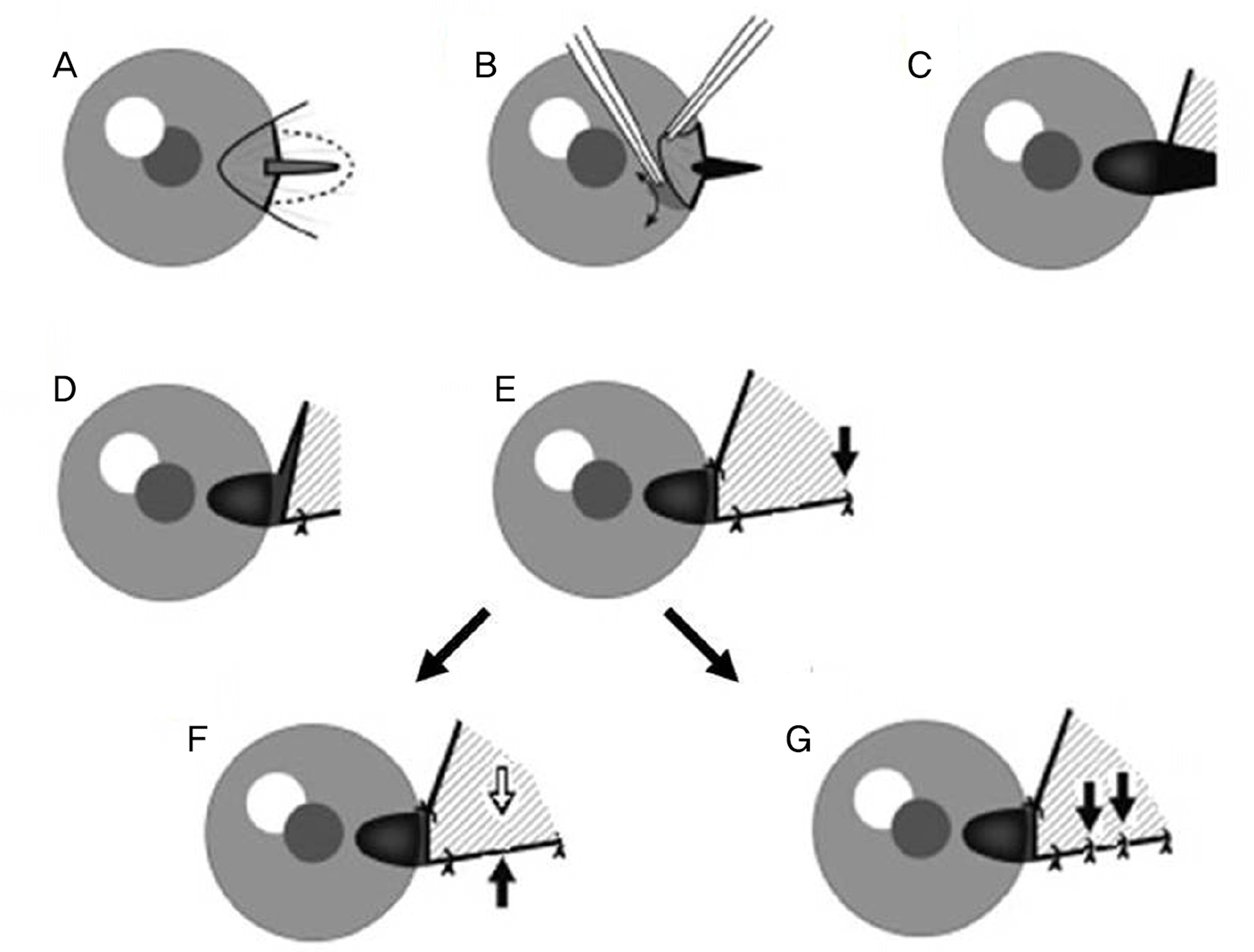Abstract
Purpose
To analyze the long-term clinical outcomes after use of fibrin glue using a modified mini-flap technique for pterygium surgery.
Methods
This study is a retrospective, clinical outcome study of 148 subjects that underwent the modified mini-flap technique with fibrin glue from January 2014 to August 2015. We analyzed the recurrence rate and surgical time of modified mini-flap sur-gery with fibrin glue. We also analyzed associating factors between the recurrence group and non-recurrence group who under-went the same surgery technique.
Results
Mean age was 60.2 ± 1.1 (ranging from 29 to 86) years, and mean surgical time was 11.8 ± 5.8 (ranging from 5 to 36) minutes. The recurrence rate of pterygium patients who underwent the fibrin glue using a modified mini-flap technique was 4.0% (6/148), and the re-operation rate was 0.6% (1/148). From the comparison of associating factors between recurred and non-re-curred groups, the recurred group was younger, had more severe disease, and had a higher rate of bilaterality than the non-re-curred group (p < 0.05).
Conclusions
The new approach using fibrin glue with a modified mini-flap technique shows a low recurrence rate compared to the other type of pterygium surgery. The use of fibrin glue shortened operation time and decreased patient discomfort due to few-er remnant sutures. Fibrin glue use in a modified mini-flap technique can be considered as a feasible surgical option for ptery-gium patients.
Go to : 
References
2. Wong VA, Law FC. Use of mitomycin C with conjunctival auto-graft in pterygium surgery in Asian-Canadians. Ophthalmology. 1999; 106:1512–5.

3. Young AL, Leung GY, Wong AK. . A randomised trial comparing 0.02% mitomycin C and limbal conjunctival autograft after ex-cision of primary pterygium. Br J Ophthalmol. 2004; 88:995–7.

4. Akura J, Kaneda S, Matsuura K. . Measures for preventing re-currence after pterygium surgery. Cornea. 2001; 20:703–7.

5. Kim M, Chung SH, Lee JH. . Comparison of mini-flap techni-que and conjunctival autograft transplantation without mitomycin C in primary and recurrent pterygium. Ophthalmologica. 2008; 222:265–71.

6. Park SY, Han KE, Seo KR. Recurrence after modified mini-flap technique for pterygium surgery. J Korean Ophthalmol Soc. 2012; 53:1419–24.

7. Tsim NC, Young AL, Jhanji V. . Combined conjunctival rotational autograft with 0.02% mitomycin C in primary pterygium surgery: a long-term follow-up study. Br J Ophthalmol. 2015; 99:1396–400.

9. Koranyi G, Seregard S, Kopp ED. The cut-and-paste method for primary pterygium surgery: long-term follow-up. Acta Ophthalmol Scand. 2005; 83:298–301.

10. Kim HH, Mun HJ, Park YJ. . Conjunctivolimbal autograft using a fibrin adhesive in pterygium surgery. Korean J Ophthalmol. 2008; 22:147–54.

11. Kheirkhah A, Casas V, Sheha H. . Role of conjunctival in-flammation in surgical outcome after amniotic membrane trans-plantation with or without fibrin glue for pterygium. Cornea. 2008; 27:56–63.

12. Fernandes M, Sangwan VS, Bansal AK. . Outcome of ptery-gium surgery: analysis over 14 years. Eye (Lond). 2005; 19:1182–90.e1.

13. Han SB, Jeon HS, Kim M. . Risk factors for recurrence after pterygium surgery: an image analysis study. Cornea. 2016; 35:1097–103.e1.
Go to : 
 | Figure 1.Modified mini-flap technique with Fibrin glue. (A) Create conjunctival window on pterygium neck. (B) Remove ptery-gium from head to body. (C) Conjunctival relaxing incision for preparing a flap. (D) A conjunctiva-sclera-conjunctiva suture at 0.4 mm apart from corneolimbal margin. (E) A conjunctiva-sclera-conjunctiva suture at inner-most part of a conjunctival flap (black-ar-row). (F) Apply fibrinogen (black-arrow) under conjunctival flap and thrombin (white-arrow) above conjunctival flap. (G) Additional multiple conjunctival sutures (black-arrows) in Mini-flap technique without Fibrin glue. |
 | Figure 2.Representative pre and post operative pictures of Fibrin glue using modified Mini-Flap technique for pterygium surgery. (A) Preoperative in patient received fibrin glue using modified mini-flap technique. (B) Postoperative 1 day in patient received fibrin glue using modified mini-flap technique. (C) Preoperative in severe pterygium case patient received fibrin glue using modified mini-flap technique. (D) Postoperative 1 month in severe pterygium case patient received fibrin glue using modified mini-flap technique. |
Table 1.
Demographic characteristics of patients
| Characteristics | Value |
|---|---|
| Number of eyes | 148 eyes |
| Age (years) (range) | 60.2 ± 1.1 (29-86) |
| Sex (male/female) | 80/68 |
| Surgical time* (minutes) (range) | 11.8 ± 5.8 (5-36) |
| Severe case (n, %) | 53 (35.8) |
| Previously operated case (n, %) | 21 (14.2) |
| Bilateral case (n, %) | 64 (43.2) |
Table 2.
Recurrent periods of fibrin glue using mini-flap technique in pterygium surgery
| Period | Rate (number) |
|---|---|
| Post-op. 1 week | 0.7% (1 case) |
| Post-op. 1 month | 0.0% (0 case) |
| Post-op. 3 months | 2.7% (4 cases) |
| Post-op. over 3 months | 0.7% (1 case) |
Table 3.
Differences between recurrence and non-recurrence cases of fibrin glue using mini-flap technique in pterygium surgery
| Non-recurrence (142 cases) | Recurrence (6 cases) | p-value | |
|---|---|---|---|
| Age (years) | 61.02 ± 12.20 | 41.17 ± 15.10 | 0.023* |
| Sex (male/female) | 78/64 | 2/4 | 0.515† |
| Severe case (case, %) | 48, 33.8% | 5, 83.3% | 0.013† |
| Previously operated case (case, %) | 20, 14.1% | 1, 16.7% | 0.860† |
| Bilaterality (case, %) | 59, 41.5% | 5, 83.3% | 0.043† |




 PDF
PDF ePub
ePub Citation
Citation Print
Print


 XML Download
XML Download